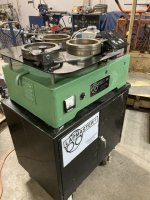e-fishin-c
Cast Iron
- Joined
- Jan 1, 2008
- Location
- Hooksett, NH
Picked up a 20” Lapmaster for refinishing hydraulic component valve plates.
The machine was reasonably tooled but set up for some other purpose, possibly ceramic or glass lapping. The original lapping plate was cast iron but not serrated so we purchased a new replacement OEM cast iron plate, abrasive media and oil vehicle to start fresh.
I am missing the original slurry pump and related tubing to dispense the abrasive media, the machine did come with a peristaltic fluid pump and a SS 7.25” dia x 8.25” deep tank for the slurry. I believe the OEM was a Graymills 110vac 1/15 hp pump.
I am looking for the pump nameplate info and model to possibly outsource a replacement pump. The tubing I should be able to fabricate using materials I already have but a few closeup pics would helpful. The mechanical timer switch needs some love (sticking buttons), might change it to digital in the future.
I am open to any and all suggestions as I am a newbie to mechanized lapping. Learning how to keep the plate flat will be my mission.
Thanx in advance.
Bill
The machine was reasonably tooled but set up for some other purpose, possibly ceramic or glass lapping. The original lapping plate was cast iron but not serrated so we purchased a new replacement OEM cast iron plate, abrasive media and oil vehicle to start fresh.
I am missing the original slurry pump and related tubing to dispense the abrasive media, the machine did come with a peristaltic fluid pump and a SS 7.25” dia x 8.25” deep tank for the slurry. I believe the OEM was a Graymills 110vac 1/15 hp pump.
I am looking for the pump nameplate info and model to possibly outsource a replacement pump. The tubing I should be able to fabricate using materials I already have but a few closeup pics would helpful. The mechanical timer switch needs some love (sticking buttons), might change it to digital in the future.
I am open to any and all suggestions as I am a newbie to mechanized lapping. Learning how to keep the plate flat will be my mission.
Thanx in advance.
Bill



